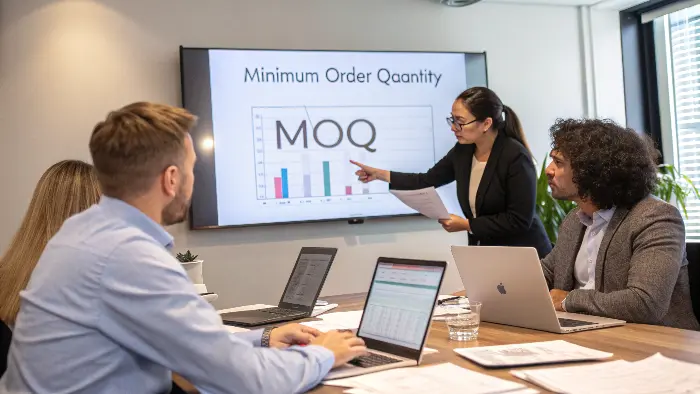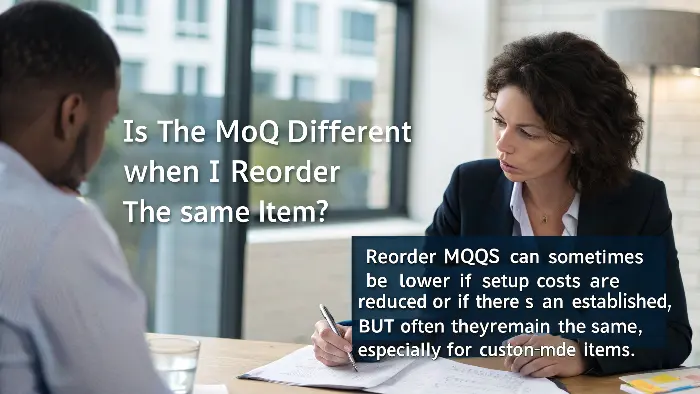Struggling with supplier MOQs on stationery? High minimums eating into your budget or leaving you with excess stock? Understanding MOQs helps you negotiate better and import smarter.
Minimum Order Quantity (MOQ) is the fewest units a supplier, like Panoffices, requires you to buy per order. It ensures production is viable and covers costs for both parties.
Navigating the world of importing stationery, especially when you’re looking for custom designs like our German buyer Michael often does, means you’ll bump into "MOQ" a lot. It can seem like a hurdle, right? But honestly, MOQs aren’t there just to make life difficult for buyers. From our side at Panoffices, they’re a crucial part of making sure we can deliver quality products efficiently. Let’s break down what this all means for you.
What Exactly IS a Minimum Order Quantity (MOQ) Anyway?
Confused by the term MOQ popping up everywhere? It feels like a barrier, doesn’t it? Understanding it is key to unlocking better supplier relationships and deals.
MOQ, or Minimum Order Quantity, is the smallest amount of a specific product a supplier will sell in one go. It’s set to cover costs and make production worthwhile.
So, you’re browsing for some slick new pens or those custom-branded notebooks for your company, and bam! You see "MOQ: 1000 pieces." What’s that all about? I remember when I first started in the stationery biz, I thought MOQs were just a way for big factories to push more product. But it’s a bit more nuanced than that – and super important if you’re a buyer like Michael, who’s always looking for that perfect balance between quality, customization, and cost for his European brand.
MOQ stands for Minimum Order Quantity. It’s essentially the smallest number of units of a particular item that a supplier (that’s us, Panoffices!) is willing to produce and sell in a single order. Think of it like this: if you’re baking a batch of cookies, you wouldn’t just bake one, right? The effort to get all the ingredients out, preheat the oven, and clean up is the same whether you bake one cookie or a dozen. Suppliers are a bit like that, but on a much bigger scale!
There are a few reasons why we, and most manufacturers, have MOQs:
- Production Efficiency: Setting up machinery, calibrating colors, and getting a production line ready for a specific item (like a custom-debossed journal Michael might order) takes time and resources. Spreading these setup costs over a larger number of units makes each unit cheaper. Producing just a handful would make each one incredibly expensive.
- Material Sourcing: We often have to buy raw materials – paper, ink, cover materials – in bulk ourselves from our suppliers. They have their own MOQs! So, we need to order enough from you to make sense of our own material purchases.
- Cost Coverage: Beyond materials, there are costs for labor, design proofing, quality checks, packaging, and shipping. An MOQ helps ensure the order value is enough to cover all these overheads and still make a tiny bit of profit. We’re a business, after all! 😉
- Inventory Management: For custom orders, we don’t typically hold stock. We make it for you. So, the MOQ ensures the production run is substantial enough.
MOQs can be set in units (e.g., 500 pens) or sometimes as a minimum order value (e.g., $2000 worth of assorted items). For us at Panoffices, it’s usually unit-based for specific custom products. It’s not about being difficult; it’s about making the whole process feasible and sustainable for everyone.How do suppliers even come up with these MOQ numbers?
Ever wonder how suppliers decide on an MOQ? It seems arbitrary, but there’s a method to the madness! Understanding this helps you see why they’re necessary.
Suppliers calculate MOQs based on production setup costs, raw material minimums from their own vendors, labor, overheads, and desired profit margins to ensure each order is viable.

It might seem like we just pluck these MOQ numbers out of thin air, right? "Oh, 1000 pieces for this notebook sounds good!" But trust me, there’s a whole lot more that goes into it. When Michael from Germany sends us a new design for a planner, we don’t just guess the MOQ. We actually sit down and crunch some numbers. It’s a bit like figuring out the recipe for a big cake – you need to know how much of each ingredient you need for it to turn out right and be worth the effort.
Here’s a peek behind the curtain at how we, and most manufacturers, figure out MOQs:
- Setup Costs (The Big One!): This is a major driver. Think about a custom-printed notebook cover. We have to create printing plates, mix specific Pantone ink colors, set up the printing press, and then the binding machines. These setup tasks cost money and time, regardless of whether we print 100 covers or 1000. If we only print 100, the setup cost per notebook is huge. If we print 1000, that cost gets spread out, making each notebook much more affordable.
- Raw Material MOQs: This is a biggie. We buy paper in giant rolls or pallets. Our paper suppliers have their own MOQs. If we need a specific textured paper for Michael’s premium line, we might have to buy a minimum quantity of that paper that’s enough to make, say, 500 notebooks. We can’t just buy enough for 50.
- Labor & Time: Every order involves labor – from a designer checking the artwork, to the machine operators, to the quality control team, to the packers. Smaller orders can sometimes take almost as much administrative and setup labor as slightly larger ones, making the per-unit labor cost very high for tiny runs.
- Operational Overheads: This includes things like factory rent, electricity, machinery maintenance, and even the coffee in the breakroom! These costs need to be covered by the sales we make.
- Profit Margin: We need to make a small profit on each order to stay in business, invest in new technology, and develop cool new products for folks like Michael. The MOQ helps ensure the order size is large enough for this.
- Complexity of Customization: A very simple, one-color logo print on a stock pen might have a lower MOQ than a completely custom-designed, multi-material notebook with special finishes like foil stamping and custom-printed endpapers. More complex jobs often mean more intricate setups and potentially specialized materials, which can push the MOQ up.
So, it’s a balancing act. We try to set MOQs that are reasonable for our customers while ensuring the production run is economically viable for us. It’s not just a random number; it’s based on real costs. When we tell Michael the MOQ for a new eco-friendly pen, it’s because we’ve factored in the cost of the recycled materials, the specific molding requirements, and the minimum run size our machines need to be efficient.What does MOQ mean when I’m actually buying stuff for my business?
MOQ feels like a restriction when sourcing? It’s actually a key factor in your procurement strategy, impacting costs, inventory, and supplier choice.
In procurement, MOQ is the minimum purchase obligation for an item. It affects your upfront investment, storage needs, unit cost, and supplier negotiation leverage.

Okay, so we’ve talked about why we as suppliers set MOQs. But what does it mean for you, the buyer – say, if you’re in Michael’s shoes, managing procurement for a whole stationery line? This is where the rubber meets the road, and the MOQ becomes a really practical part of your purchasing decisions. It’s not just a number; it’s a strategic factor. I often chat with Michael about how MOQs for different products in our Panoffices range fit into his overall inventory planning and budget.
Here’s how MOQs directly impact your procurement process:
- Upfront Investment: This is the most obvious one. A higher MOQ means a larger initial cash outlay. If a fancy new pen has an MOQ of 5,000 units at $0.50 each, that’s a $2,500 investment right there, not including shipping or import duties. You need to be sure you can sell them or use them!
- Inventory & Storage: Ordering at MOQ means you’ll have at least that many units to store. Do you have the warehouse space? How long will it take to move that stock? This is especially crucial for seasonal items or products with a shorter shelf-life (though less so for most stationery). Michael has to plan his warehouse space in Germany carefully based on the MOQs of the various notebooks, pens, and desk accessories he orders from us.
- Unit Cost & Economies of Scale: Generally, meeting or exceeding the MOQ gets you a better per-unit price. Ordering below MOQ (if a supplier even allows it, often with a surcharge) makes each item more expensive. This is where the "sweet spot" comes in – ordering enough to get good pricing without overstocking.
- Risk Management: Ordering a large quantity due to a high MOQ increases your risk if the product doesn’t sell as well as expected, or if market trends change. This is why new, untested products are sometimes tricky if the MOQ is high.
- Supplier Relationships & Negotiation: Understanding a supplier’s MOQ rationale can sometimes open doors for negotiation. Maybe you can’t meet the MOQ for one item but can place a larger total order across several items. Or perhaps if you commit to regular orders, there can be some flexibility. Building a good relationship, like the one we have with Michael, helps here. We know his brand’s needs and can sometimes work on solutions together. For example, if an MOQ is 1000 for a custom color, but 500 for a standard color, he might opt for the standard to begin with.
- Product Variety vs. Depth: MOQs can influence how wide a product range you can carry. If every new item has a high MOQ, you might be forced to stock fewer different items but in greater depth.
Essentially, for a procurement manager, the MOQ is a critical data point that feeds into budgeting, forecasting, risk assessment, and logistics planning. It’s not just about getting the stuff; it’s about getting it in a way that makes business sense.Is the MOQ different when I reorder the same item?
Wondering if reordering gets you a lower MOQ? Sometimes, but not always. It depends on supplier policies and your relationship.
Reorder MOQs can sometimes be lower if setup costs are reduced or if there’s an established relationship, but often they remain the same, especially for custom-made items.

This is a really good question, and one Michael asks us from time to time, especially when he’s planning his inventory for best-selling items. "Okay, Panoffices team," he might say, "we blasted through those blue A5 notebooks! Can I get a smaller batch this time since you already have all the specs and tooling?" It’s a logical thought – if the initial setup is done, reorders should be easier, right?
The answer is… it depends! Sometimes, yes, there can be more flexibility on reorders, but often the MOQ stays the same. Here’s why:
- Setup Costs (Again!): Even for a repeat order, some setup is usually still required. Machines need to be recalibrated for that specific product, materials need to be loaded, and quality checks for that particular run need to be implemented. While we might have the printing plates or molds from the first order (which saves that specific cost), the operational setup still takes time and resources. For example, if we made 10,000 custom pens for Michael last time, and now he wants 500, we still have to dedicate a machine’s time, which might otherwise be used for a larger run of another product.
- Raw Material Minimums: This often doesn’t change. We still need to order our paper, ink, or plastic from our suppliers, and they still have their MOQs. If we need a specific shade of blue paper for Michael’s notebooks, we might still need to buy a minimum amount, even if his reorder is smaller. We can’t just buy half a roll of special paper.
- Production Scheduling: Factories like ours run on schedules. Fitting in a very small "top-up" order can sometimes disrupt the flow of larger, planned production runs. It’s like trying to squeeze in a tiny errand when you have a day packed with big meetings – sometimes it works, sometimes it’s just not efficient.
- Established Relationships & Volume: This is where things can get more flexible! If you’re a regular customer like Michael, with consistent volume over time, we’re much more likely to try and accommodate a slightly smaller reorder if it’s genuinely needed. We value the long-term partnership. Perhaps we can bundle your smaller reorder with another similar production run, or we might have some leftover materials from a previous, larger run that could be used. But this is more about good customer service and less about a formal change in the stated MOQ.
- "Stock" vs. "Custom-Made": If it’s a standard item that a supplier does keep some components for, reorder MOQs might be lower. But for highly customized items, like many of the unique products Panoffices creates, each order is essentially "made to order," so the original MOQ logic often still applies.
So, while it’s always worth asking your supplier about reorder quantities, don’t automatically assume the MOQ will drop significantly. The core economics of production often remain similar. What can change is the supplier’s willingness to find a solution for a valued, repeat customer. That’s where good communication and a strong business relationship really pay off! 🔥Conclusion
Understanding MOQs empowers you to negotiate better, manage inventory wisely, and choose suppliers like Panoffices that align with your stationery import goals and business scale.

